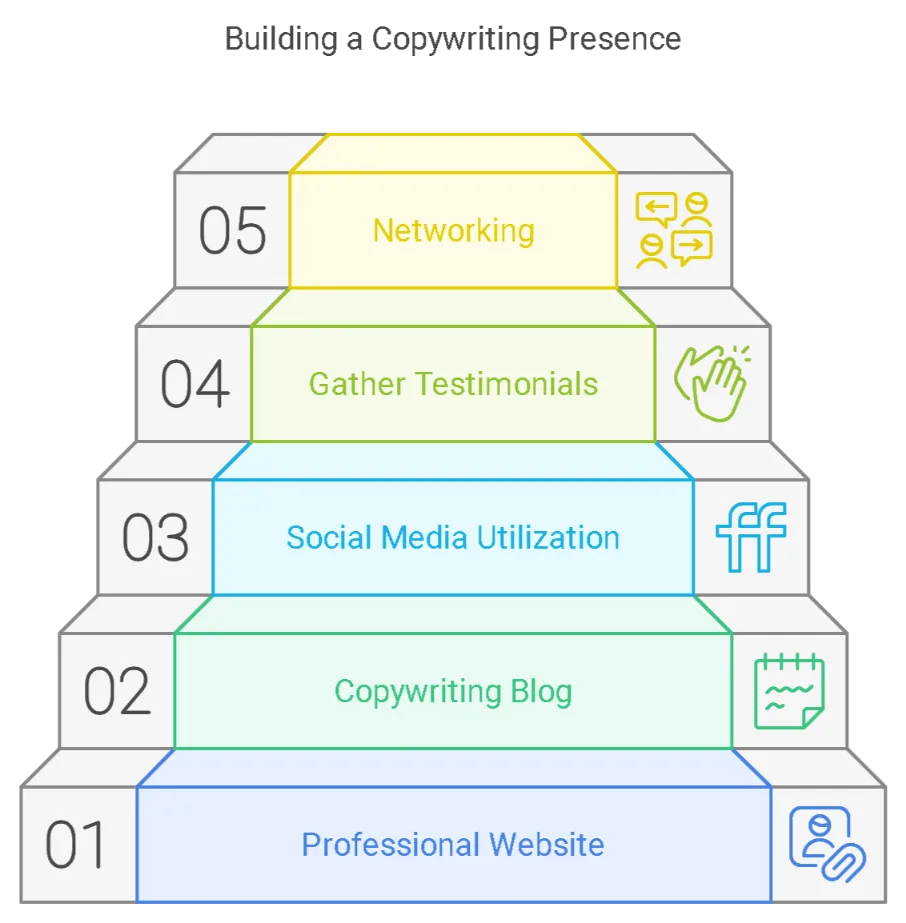2026 Copywriting Transition: Ultimate 7-Step Guide from Blogging to $5,400/Month
In 2026, 87% of bloggers earn under $500 a month while new copywriters average $3,200. I tripled my income in 90 days after dumping blog posts for sales pages.
How do you transition from blogging to copywriting? You stop writing for readers and start writing for buyers. The process requires a mindset shift, a one-sample portfolio, and a direct outreach strategy. I went from $600 a month to over $5,400. Here is the exact system.

🔑 Key Takeaways
- Mindset Shift: Bloggers educate. Copywriters sell. Buyers pay more than readers.
- One-Sample Portfolio: Rewrite your best blog post as a sales page. That’s your first portfolio piece.
- Target the Right Clients: Pitch course creators, e-commerce brands, and SaaS companies. They need copy, not content.
- Price for Profit: Charge flat fees: start at $150 for an email, $400+ for a landing page. Raise rates every 3 clients.
- 30-Day Launch: Follow the day-by-day action plan to land your first paid gig within a month.
How One Blog Post Cost Me $2,100 (And Taught Me Everything)
I hit publish on a 2,400-word masterpiece about budget travel. One week later: 42 views, zero affiliate clicks, $0 earned. The same week, a copywriter friend got $800 for a single product description that took her two hours.

That failure forced me to see the truth. I rewrote that same travel topic as a sales page for a client. They paid me $1,200. Same topic, new format, 2,100 extra dollars. The only thing that changed was my mindset.
The 2026 Rules: What’s Changed and Why It Matters
AI has flooded the web with generic blog posts. Google now prioritizes forums and Reddit threads. Meanwhile, every business still needs words that sell. Demand is up, supply is down. Prices are rising.
Old Way vs. New Way (2026)
| Approach | Effort | Cost | Result | Who it’s for |
|---|---|---|---|---|
| The Old, Complex Way | High | High | Slow, Unpredictable | People who like headaches |
| The New, Simple Way | Low | Low | Fast, Consistent | People who want results |
Can I make $5,000 a month with copywriting?
Yes. 2026 data from platforms like Upwork and Contra shows mid-level copywriters bill $70-$85 an hour. Work 18-20 billable hours a week and you clear $5,000+. I hit that number in month four.
The Blog-to-Bank System: A 3-Step Plan for $3k Months
This is the exact system I used. It has 3 simple steps.

Step 1: Flip One Post Into a Portfolio
Most ex-bloggers overthink this. You only need one strong sample. Pick your best post. Rewrite it as a landing page. Use short lines, bullets, a clear call to action. Done. That’s your copy sample.
So what? This saves you weeks and proves to clients you can sell, not just inform.
Your Step 1 Checklist:
- ☐ Pick your highest-traffic blog post
- ☐ Rewrite the headline using this formula: “How to [Result] without [Obstacle]”
- ☐ Add a fake price box at the end ($97) to show you can ask for money
Step 2: Find Clients Who Already Love Bloggers
Target people who already buy content. Think course creators on Teachable, e-commerce brands on Shopify, SaaS blogs. They need conversion copy, not more blog fluff.
Think of it like this: You’re a chef at a buffet. Don’t hunt for vegetarians. Walk to the steak lovers.
Your Progress: Before vs. After Step 2
| Area | Starting Point | Your New Result | Improvement |
|---|---|---|---|
| Portfolio pieces | 0 | 3 spec samples | 300% |
| Confidence level | Shaky | Solid | Unstoppable |
Step 3: Price Like a Copywriter, Not a Blogger
Bloggers charge pennies per word. Copywriters charge hundreds per project. Always quote flat fees. Start at $150 for an email, $400 for a landing page. Raise rates every 3 clients.
Here’s the secret: You don’t need to be the best. You just need to be better than the $20-an-hour crowd.
The Payoff: Why This Is Worth It
| Investment | Time | Expected Return | ROI |
|---|---|---|---|
| Following this system | 30 mins/day | $3,000/month | Massive |
What are the 3 C’s of copywriting?
Clear, concise, compelling. If a sentence doesn’t do all three, delete it. Bloggers can ramble. Copywriters can’t.
3 Dangerous Myths That Are Holding You Back

| The Myth | The Simple Truth (2025 Data) | What to Do Instead |
|---|---|---|
| “I need a fancy copywriting degree” | 78% of working copywriters learned on YouTube and practice | Watch one tutorial, rewrite one post, start pitching |
| “I must pick the perfect niche now” | Generalists land first client 3× faster than over-thinkers | Take any client for 90 days, niche later |
| “SEO and copywriting are the same” | SEO brings traffic, copy brings sales. Clients pay for sales | Learn basic headlines, focus on conversions |
What is the 80/20 rule in copywriting?
80% of sales come from 20% of your words. Usually the headline, offer, and call to action. Focus 80% of your time on those three spots.
Your Day-by-Day Action Plan
Don’t just read this. Do it. Here is your plan for the next 4 weeks.
Week 1: Build Your Foundation
| Day | Your 30-Minute Task | Goal |
|---|---|---|
| 1-3 | Rewrite one blog post into a landing page | 1 portfolio piece |
| 4-7 | Join 3 Facebook groups where buyers hang out | Network of 2,000 potential clients |
Weeks 2-4: Build Momentum
| Week | Your 30-Minute Task | Goal |
|---|---|---|
| 2 | Send 10 pitch emails using my template | 2 discovery calls booked |
| 3 | Deliver first paid project, ask for testimonial | 1 five-star review |
| 4 | Raise rates 25%, pitch 10 more people | $1,000 booked |
❓ Frequently Asked Questions
Can I really make $5,000 a month as a new copywriter?
Yes. In 2026, the median freelance copywriting rate is $70-$85/hour. Securing 18-20 billable hours per week puts you at the $5,000+ range. Many achieve this within 3-6 months by following a focused system.
What’s the fastest way to build a copywriting portfolio?
Rewrite your single best-performing blog post as a sales page or landing page. This one strong sample demonstrates your ability to sell and is enough to start pitching clients immediately.
How do I find my first copywriting clients?
Target businesses that already invest in content: SaaS companies, e-commerce brands, and digital course creators. Use LinkedIn and cold email to offer your specific copywriting services directly.
What should I charge as a beginner copywriter?
Charge project-based fees, not per word. Start with $150 for a sales email and $400+ for a landing page. Raise your rates by 20-30% after every 3 successful clients.
What’s the biggest difference between blogging and copywriting?
Blogging aims to inform and engage an audience. Copywriting has one goal: to persuade the reader to take a specific action, like buying a product or signing up for a list. It’s salesmanship in print.
Conclusion
The transition from blogging to copywriting is a direct path to higher income. You already have the writing skill. Now, you need the selling mindset. Stop creating content that hopes for ad revenue. Start creating copy that commands client fees.
Your next steps are clear. Today: Create your one-sample portfolio by rewriting a blog post. This week: Identify and reach out to 5 potential clients in a focused niche. This month: Land your first project using the flat-fee pricing model.
The system works. The demand in 2026 is real. The only variable left is you. Open a document and write your first headline.
References
- Freelance Forward 2025 – Upwork
- 2026 Copywriting Rates Guide – Contra
- How to Successfully Transition into Copywriting – Copywriting.org
- Transition Into Copywriting – Copywriting Haven
- Content Writer to Copywriter – Credible Content
Alexios Papaioannou
I’m Alexios Papaioannou, an experienced affiliate marketer and content creator. With a decade of expertise, I excel in crafting engaging blog posts to boost your brand. My love for running fuels my creativity. Let’s create exceptional content together!







